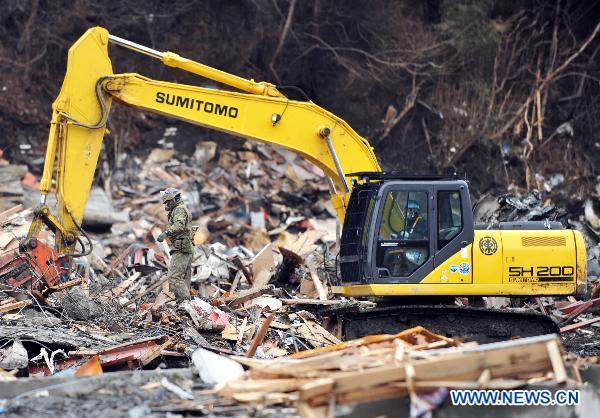String of quakes jolt NE Japan
Several strong earthquakes, including a 6.0 magnitude on Richter scale, jolted northeastern Japan Wednesday morning, but the troubled Fukushima nuclear power plants were not damaged by the series of quakes, according to Xinhua News Agency.
|
An excavator works on debris in Otsuchi of Iwate Prefecture, Japan, March 21, 2011. Otsuchi is one of the worst devastated area in the earthquake and tsunami. |
No tsunami warnings have been issued so far, while the Fukushima Daiichi and Daini nuclear power plants were not damaged by the series of quakes and the ongoing reconstruction work there was not hindered, according to the Nuclear and Industrial Safety Agency.
The 6.0 tremor jolted mainly Fukushima Prefecture, where a disaster has been unfolding at the Daiichi nuclear power plant in the wake of the March 11 quake, at 7:12 a.m. (local time).
Tokyo Electric Power Co. continued reconstruction work at the troubled Fukushima Daiichi nuclear power plant on Wednesday, aiming at restoring lost functions at its No. 1 to No. 4 reactors.
After the 9.0 magnitude that hit Japan, massive tsunami knocked out the cooling system of the Fukushima nuclear power plants, where radioactive materials have been leaked out.
The National Police Agency said Tuesday that the catastrophic earthquake and ensuing tsunami have left 9,079 people dead and 12, 645 others unaccounted for in Japan by 12:00 local time (0300 GMT).
Death toll rises to 9,301 from great quake-tsunami in Japan
The National Police Agency said Wednesday that the catastrophic earthquake and ensuing tsunami have left 9,301 people dead and 13,786 others unaccounted for in Japan by 09:00 local time (0000 GMT), according to Xinhua News Agency.
A 9.0-magnitude earthquake hit the Pacific coastal areas of northeastern and eastern Japan on March 11, triggering enormous tsunami.
Heavy casualties and extensive damage have been caused by the twin disasters.
Food radiation concerns
"There continue to be some improvements at the Fukushima Daiichi nuclear power plant but the overall situation remains very serious," Graham Andrew, an official from the International Atomic Energy Agency (IAEA), said, China Daily via Agencies reported Wednesday.
He said the IAEA had not received validated information for some time about about the "containment integrity" of the plant's No.1 unit and it was concerned it did not know its exact status.
"It would be particularly valuable to have data about the damage which has been suspected to that containment integrity and the core and fuel integrity," Andrew said.
"Has there been melting? Is it buckling?"
He said he did not think the Japanese were holding back data but rather that they simply did not have it themselves.
Japanese media reported on Tuesday that lighting had been restored at one of the control rooms, bringing the operators a step closer to reviving the plant's cooling systems.
Earlier smoke and steam were seen rising from two of the most threatening reactors, No 2 and No 3, threatening to dash hopes of progress in bringing them under control.
Mounting evidence of radiation in vegetables, water and milk in areas near the plant has also stirred concerns, despite officials' assurances that the levels were not dangerous.
"The agency continues to receive data confirming high levels of radiactivity in food, notably spinach, in samples taken from 37 locations in the vicinity of five cities to the south of the Fukushima site," Andrew said.
"This indicates that in four prefectures some food products are above permissible levels," he said.
High levels of both iodine 131 and caesium 137 were being measured by the Japanese authorities in spinach and some other fresh vegetables together with iodione 131 in milk, he said.
Japanese authorities have already stopped shipments of milk and some vegetables from the area.
Minuscule numbers of radioactive particles believed to have come from Fukushima have been detected as far away as Iceland, officials said on Tuesday.
 0
0 








Go to Forum >>0 Comments